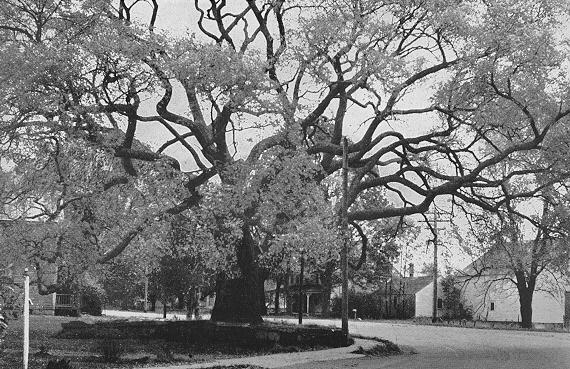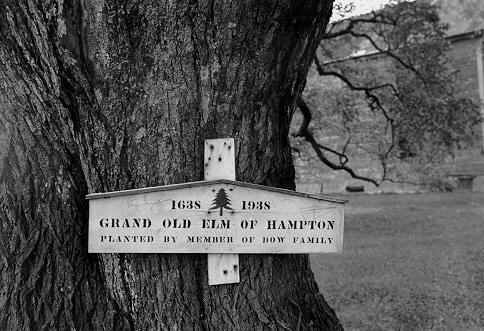Hampton Union
Thursday, August 2, 1956

Dept. of Agriculture marking it as suspect of the Dutch Elm disease. State entomologists this week
gave out the report — the historic landmark at Elmwood Corner must be destroyed. [–Staff Photo]
Hampton’s famous “Old Elm,” believed to be over 300 years old located on Winnacunnet road Elmwood Corner, is one of 16 elm trees marked for destruction because of the killing Dutch elm disease, it was learned today. by the Union.
In an interview with Prof. James G. Conklin, state entomologist at the University of New Hampshire, the Union was told that the dreaded Dutch elm dis ease was definitely on the increase in Hampton which had only 10 trees infected up until this year, when the recently completed survey disclosed 16 more trees which must be destroyed if the scourge is to be halted locally.
Prof. Conklin told the Union that property owners, where known, and the town officials would receive the notice urging prompt removal of the infected trees, within the next 10 days.
The state entomologist stated that the N. H. Dept. of Agriculture had five two-man crews operating, throughout the state and that the recent scouting of Hampton elms turned up 16 positive reports of the presence of Dutch elm disease.
Situation “Bad”
Corroborating this report, Town Manager John W. True stated today that “the situation is bad” and that before another year goes by, the town should take steps to halt the spread of the disease.
Mr. True stated that the town spraying over the last few years had been primarily for mosquito control with whatever good might come to the tree foliage of secondary importance. This year the combination spraying was done by the Airborne Spray Co of Lexington, Mass., with two sprayings already completed and a third and final spraying within the next two weeks.
Mr. True also reported that the town was, at present, taking down several elm trees which were pegged for destruction by the state last year, under a $1,000 appropriation included in the highway department funds last March.
Trees Must Be Burned
However, he did not know what the town could do about the 16 additional trees, including the Old Elm, marked for destruction which must be cut down and burned.
According to Prof. Conklin, the state assumes no responsibility I for the removal of diseased trees which is entirely the responsibility of the property owner and the town or city. The state policy is limited to locating the diseased trees and notifying the property owners or town officials for prompt removal.
Although there is nothing mandatory about the state’s action, the notice to the property owner urges prompt removal and destruction of the tree.
The notice reads as follows: “This will notify you officially that the elm located as described on the enclosed field record form has been found this summer to be infected with the Dutch elm disease. This notice is sent to the property owner (where known) and to town and city officials.
“All trees infected with the Dutch elm disease should be removed promptly, in order to help retard spread of the disease to healthy trees in the immediate vicinity.
No State Funds Available
“There are no state funds available for tree removal; hence, it is up to private individuals and communities to see that diseased trees are removed promptly and destroyed by burning.
“The diseased tree should be cut down and either completely burned, or, in the case of large trees which cannot be completely burned, the branches can be piled along the truck section and burned, or the bark can be stripped from the main trunk and burned separately. The tree stump should be stripped of its bark in order to prevent breeding of elm bark beetles.
“Trees killed by the disease deteriorate rapidly, and thus constitute an added hazard because of the danger of injury to persons or property by falling branches, for which the owner of the tree may be held liable by the courts.” Dr Conklin told the Union that there is no known method to stop the spreading of the disease in an elm, once the tree is infected. Certain modern methods of “chemo-therapy” have been tried but with little success.
Exeter In “Tough Shape”
Programs of saving elms have been started in other seacoast communities, according to Dr. Conklin, noticeably in North Hampton and Exeter, the latter town being described as in “tough shape”. One of the hardest hit towns in the state is Salem where the community is now practically devoid of live elm trees.
Historically, the blight first arrived in New Hampshire in 1949 and the first sign of Dutch Elm disease in Hampton was spotted in 1954.
Hampton has been doing a good job up to this point, according to Dr. Conklin, but the big jump this year in infected trees is of grave concern to state entomologists.
Hurricanes At Fault
The UNH professor told the Union that the hurricanes of the past two summers were much to blame for the increase of the disease. The gale force winds were especially rough on tall elms many of which although not blown had their top branches twisted and broken, leaving the tree weak and more susceptible to attach by the elm bark beetle.
Dr. Conklin was of the opinion that unless Hampton begins an immediate program of arresting the spread of the disease, that a few years will see the end of the elm trees in this community.

believed to be over 300 years old (1956). Sign on the tree was from the
Tercentenary Celebration of the Town of Hampton, 1638-1938.
and, Dutch Elm Disease, Hampton Union, August 2, 1956]